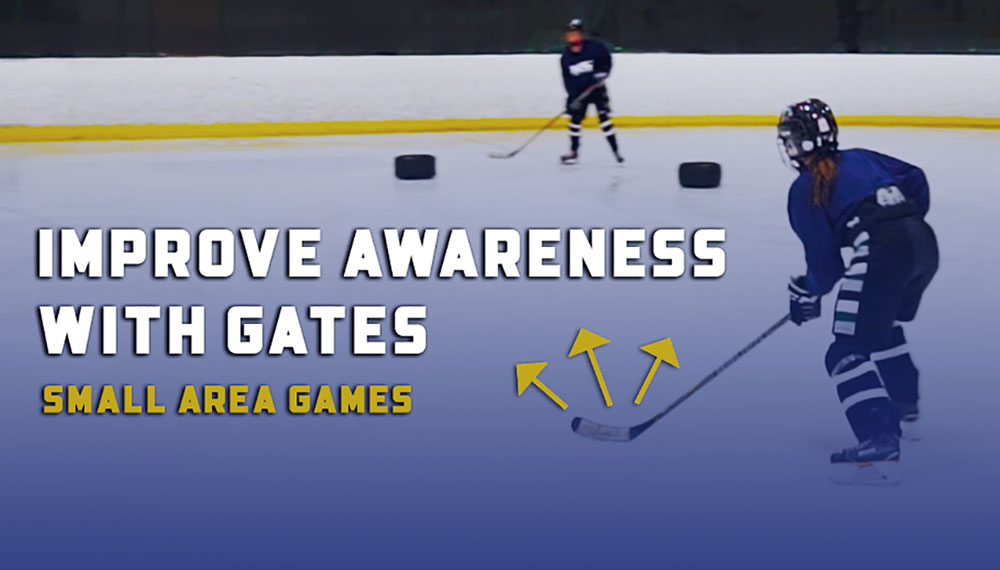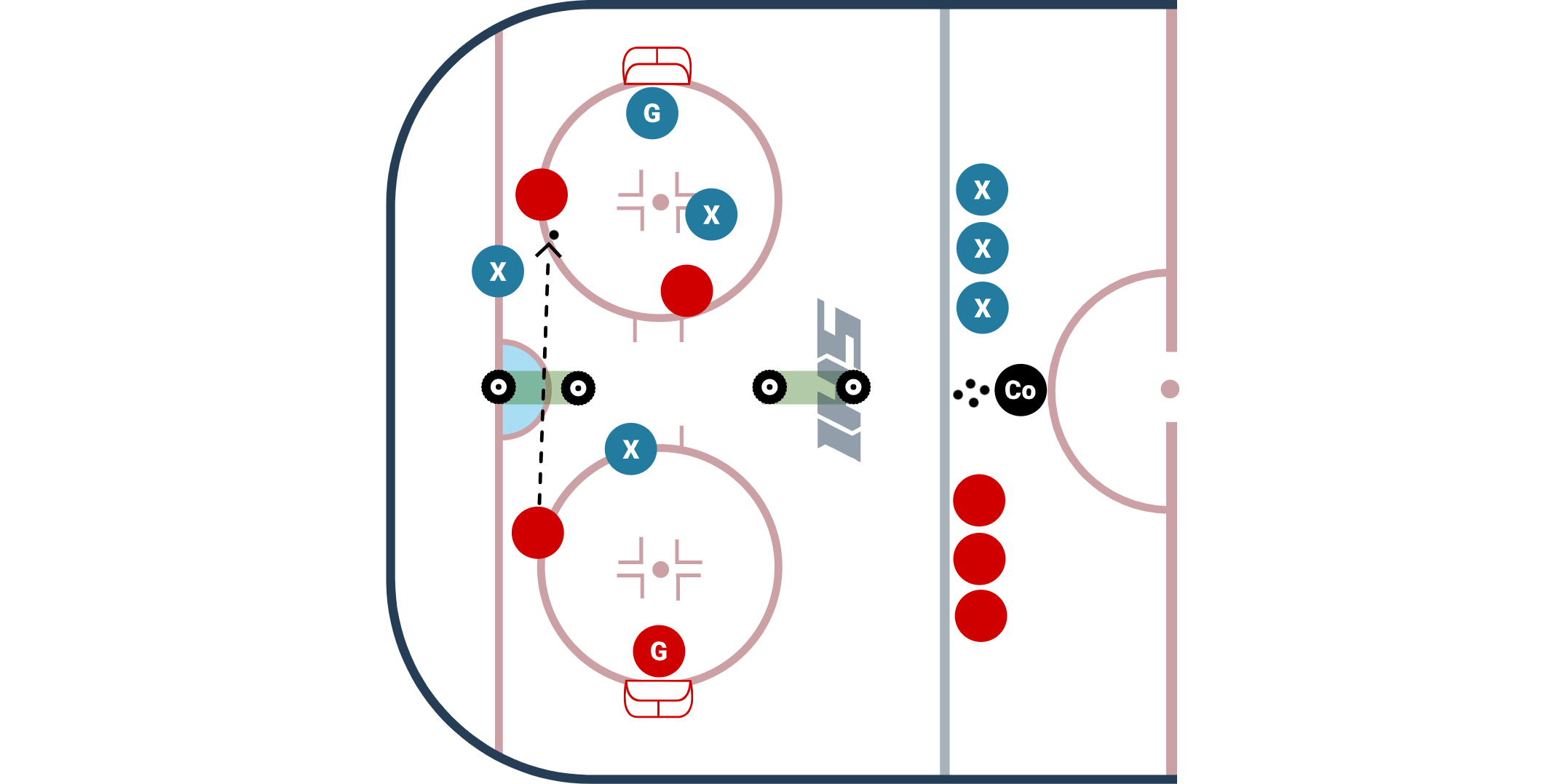
POP QUIZ: Think about the current state of your team. If you blew the whistle during any game would your players be able to answer these questions:
- Where is the puck?
- Where are your teammates?
- Where is the other team?
- Where is there open ice?
Chances are, the players have limited awareness. Most players will able to answer question # 1. Some will be able to correctly answer where one immediate teammate and defender is. Most players will not be able to let you know where most of the players on the ice are and where the open space on the ice is.
Why is it hard for players to answer the 4 questions above fully? Because most players don't practice keeping their head up and scanning the ice. Lots of teams only practice with memorization drills (static drills around a cone) and they do not practice keeping their head up to scan the ice. As a result of this, players play like they practice and only follow the puck.
Below we dive into 5 simple, yet highly effective games that use "Gates" to help players practice playing with their head up.
The games forces players to constantly keep their head up and scan the ice, to look for their teammates and the gates, which will improve their hockey awareness.
These games are great for all age and skill levels. The games can be modified to be easier or tougher depending on your team's skill level. For example, the smaller the Gate, the harder it is to score! At the bottom of this post we will dive into more variations, but for now, let's get to the games!
Game 1) Gates of Buffalo Passing
Objective: The goal of the Gates of Buffalo Passing Game is to pass the puck through the gates as many times as possible before time runs out. You can not pass through the game gate twice in a row! Keep score and challenge groups to compete for the highest score! We would suggest to start with this gates passing exercise first (Game # 1), before moving onto the 3 vs 3 situation (Game # 2 below). You can play with 3, 4, or 5 players at time.
Game 2) Gates of Buffalo 3 on 3
Objective: The goal of the Gates of Buffalo 3 on 3 Game is for each team to pass the puck through the gates as many times as possible before time runs out. You can not pass through the game gate twice in a row! Keep score! You can also play 2 vs 2, 4 vs 4 and 5 vs 5.
Game 3) Double Gates Activation
Objective: The goal of the Double Gates Activation Game is for a player with the puck to skate through a gate to activate their teammate at the point. Once they skate through the gate, a 2 on 1 is started. The defender works to stop the play or skate the puck out of the zone. You can start with a 1 on 1 that goes to a 2 on 1 or start with a 2 on 2 that goes to a 3 on 2.
Game 4) Picket Fences 2 vs. 2 or 3 vs. 3
Objective: The goal of Picket Fences 2 vs. 2 or 3 vs. 3 is for the forward team to score a goal (which counts as 2 points) and the defending team tries to skate through the gate at the point (which counts as 1 point). You can use this setup to play 1 on 1, 2 on 2, 3 on 3.
Game 5) Double Goals Game
Objective: The Double Goals Game is a fun and competitive 3 vs. 3 small area game that allows players to score goals by passing through the gates, or scoring on a goalie. A pass through the gate counts as 1 point (players can't pass through the same gate twice in a row) and a goal on the goalie counts as 3 points. The two options to score goals forces players to be creative and pick their heads up to be aware of their surroundings. Can be modified to be 2v2, 3v3, or 4v4.
Gates Game Variations
- Ice Space: Games can be played on 1/4, 1/2 or full ice.
- Scoring: Keep score between teams to encourage a natural competition. You can also give players the ability to score points by skating through a gate.
- Goalie: If you have a goalie (for the passing or 3 v 3 game), require 2 or more passes through the gates before players are allowed to take a shot on net. Once a shot is taken, the players need to go back to working on completing 2 passes before they shoot again. This will require the goalie to pay attention. Encourage the goalie to work on tracking the puck during the passing before a shot comes. If your goalie needs help on their Shuffling, or T-Pushes, have them visit our Goalie Development page.
Setup Suggestions for Elite Players
- Make the gates smaller. You can even flip a tire so it is standing up and the players need to pass through the tire.
- You can add a hockey stick at the bottom of each gate so players must "sauce" through a gate and over the stick for the point.
- Can add various obstacles on the ice such as sticks, cones, tires, etc that players must be aware of and need to stickhandle, pass and skate around.
- Require 3 or more passes before they can take a shot on net.
COACHING POINTS
- HEAD UP! Encourage players to keep their head up and scan the ice at all times.
- Get to Open Space: Encourage players to always move to open space on the ice. Do not allow them to stand still and pass the puck back and forth.
- Finding passing lanes when you have the puck and jumping to open space when you don't have the puck so your teammate can pass to you is extremely beneficial during the Gates games (and in real games).
- Verbal & Non-Verbal Communication: Encourage verbal communication (calling teammate by name, saying you are open, etc) and non-verbal communication (good eye contact, showing a passing target, tapping a stick, etc) between teammates.
- Open Up: Encourage players to open up so they can face the puck and the majority of the ice so they are in a position to scan a greater area. If they are only facing the puck and facing the boards, it's hard to know where the open ice and other players are.
- Make Mistakes: Allow players to make mistakes. It will take time to get comfortable with these activities, especially at the younger age levels. But as time goes on you will see them picking their head up to make a decision, which is the goal of these small area games.
Question for the coaches: How else can you use gates in drills or games to require your players to keep their head up and make a pass? The four games above are simple examples but this concept can be built upon with additional creativity from the coaches!
How to Further Develop Awareness
If your players get comfortable with playing Gates, continue to encourage them to play with their head up at all times. Whether it is a scrimmage, a drill, or a small area game, it is important to drive home that players should be practicing with their head up. Yes, at the beginning players will lose the puck while they are stickhandling with their head up, but over time they will get better at using their peripheral vision. We have a blog post that dives into How To Help Players Practice Playing With Their Head Up.
The whole game changes if players can keep their head up to look around before they have the puck, when they have the puck and after they get rid of the puck.
Below are 4 additional activities that will help players develop awareness and jump to open space:
- Run Ragged Small Area Game: A simple, yet effective hockey game that helps players learn how to jump to open space when they do not have the puck so they can become an outlet for their teammate.
- 7 Pass 2 on 1 Hockey Game: A game where two players work to complete 7 (or 5) passes in a row against a defenseman. It is critical for players to keep their head up, protect the puck and jump to space when they don't have the puck.
- Corner to Half Wall 2 on 1: A game where two players work together to complete 4 passes in a row against a defenseman along the corner boards. If they are successful, they get a shot on net! If the defense breaks up the play 2 times, they are awarded a shot on the net!
- Offense to Defense 2 on 2: A 2 on 2 stations where teammates must communicate with each other and keep their head up to be successful.
Related Content
- KEEP YOUR HEAD UP - Tips to for coaches to teach this important hockey habit.
- 80+ Small Area Hockey Games - small area games are great for players to work on keeping their head up and getting to open space.
- 12 Games to Practice Decision Making - a list of 6 games to help players work on their decision-making skills.
- Develop an Off-Ice Stickhandling Routine - spending a few minutes every day off of the ice will help players learn to stickhandle with their head up!


